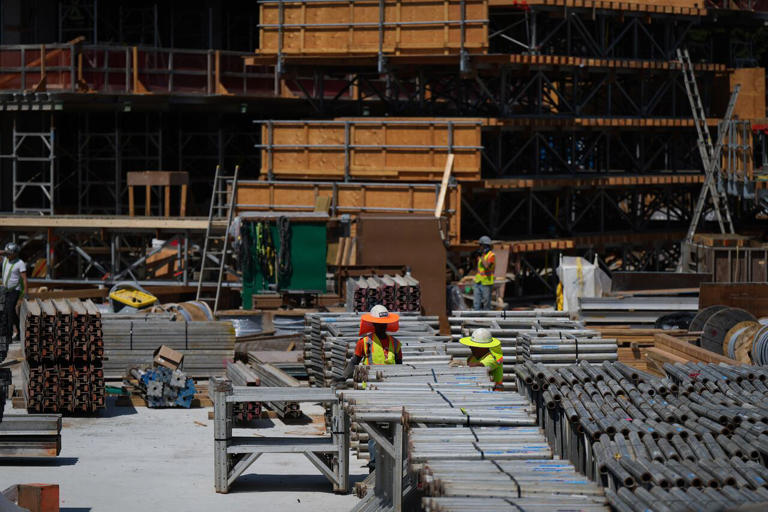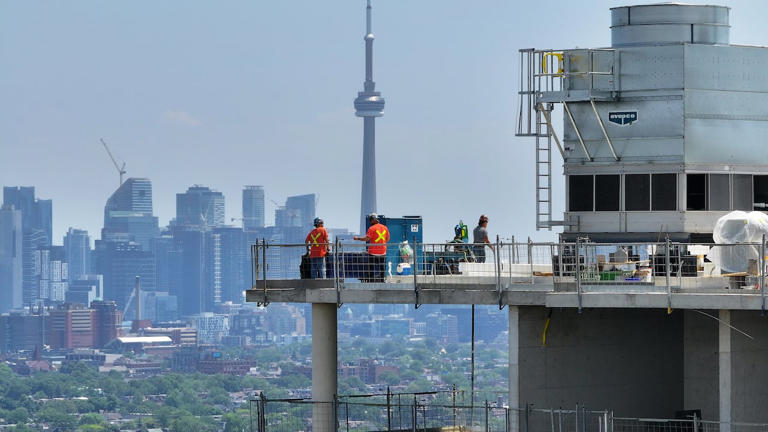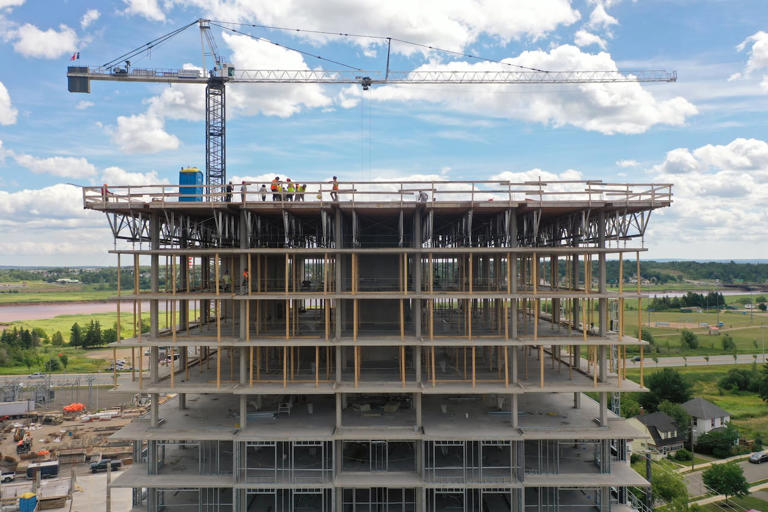Story by Geoff Nixon • Jul 14, 2023
Canada is growing rapidly — and so are its housing needs.
In turn, these pressures are testing the construction industry, which finds itself dealing with a mounting labour shortage.
There are tens of thousands of unfilled construction jobs across the country — including up to 20,000 open positions in Ontario alone — that the Labourers' International Union of North America (LiUNA) says it could fill, if only it could find the workers.
The open positions in such sectors as residential and high-rise construction include labourers, bricklayers, cement finishers and people doing trim and tile work.
"That's just one labour union," said Victoria Mancinelli, the public relations director for LiUNA in Central and Eastern Canada, describing the deficit as a partial snapshot of the broader construction labour crunch.
The industry is also facing a looming wave of retirements that will see roughly 20 per cent of Canada's construction workers retire within 10 years.
"This is not something that is unique to construction," said Bill Ferreira, executive director of industry group BuildForce Canada, referring to the labour supply challenges that surround Canada's aging workforce.
To keep construction projects moving forward, Canada will need people to build them — which is why both the industry and various levels of government are paying close attention to how many workers will be available to work on job sites now and in the future.
"It's mission critical to get more people into the trades," Ontario Labour Minister Monte McNaughton said in an interview.
Challenges differ from east to west
There are parts of Canada where the construction labour shortage is projected to be more acute than in others, and Ferreira said demographics are at the core of those regional differences.
"It's almost an east and west story," he said, noting that Prairie populations skew younger, which is advantageous for recruiting construction labour.
BuildForce Canada expects the number of pending retirements in Alberta, for example, to be nearly balanced with new recruits from the province through 2032. But even more people will need to be hired to deal with the demand for construction over that time period — and officials have signalled the province needs more construction workers now.

Construction workers are shown at a condominium tower job site in Coquitlam, B.C., in May. About 38,000 veteran builders in the province are expected to retire by 2032.
(Darryl Dyck/The Canadian Press)© Provided by cbc.ca
Ferreira said the exception in the west in British Columbia, which is expected to see 38,000 of its veteran builders retire by 2032. But local recruitment is predicted to fall thousands short in terms of the total number of new workers.
In Ontario, more than 80,000 people will exit the industry over the same time period. That's a problem in a province that is aiming to build 1.5 million new homes by 2031. The actual number of workers needed will be significantly higher than the number retiring.
McNaughton acknowledges the challenges, but he points to intensive efforts the provincial government has taken to address the supply of construction labour.
"It's a big task in front of us," he said, noting that Ontario is currently short 72,000 construction workers.

Construction workers are shown at a condo project in Toronto earlier this month. More than 80,000 Ontario construction workers are expected to retire within the next 10 years, at a time when the province has ambitious home-building plans.
Ferreira said the exception in the west in British Columbia, which is expected to see 38,000 of its veteran builders retire by 2032. But local recruitment is predicted to fall thousands short in terms of the total number of new workers.
In Ontario, more than 80,000 people will exit the industry over the same time period. That's a problem in a province that is aiming to build 1.5 million new homes by 2031. The actual number of workers needed will be significantly higher than the number retiring.
McNaughton acknowledges the challenges, but he points to intensive efforts the provincial government has taken to address the supply of construction labour.
"It's a big task in front of us," he said, noting that Ontario is currently short 72,000 construction workers.

Construction workers are shown at a condo project in Toronto earlier this month. More than 80,000 Ontario construction workers are expected to retire within the next 10 years, at a time when the province has ambitious home-building plans.
(Patrick Morrell/CBC)© Provided by cbc.ca
The minister said the provincial government has been pushing to ramp up recruitment of skilled trade workers and to encourage far more young people to enter the fiel
Ontario saw 27,319 people sign up for apprenticeships over the past 12 months — a record number that McNaughton said amounts to a 24 per cent year-over-year increase.
Further east, New Brunswick expects to see nearly one-third of its construction workers retire in the next five years. That has implications for a small province undergoing a population growth spurt.
"The [construction] industry is struggling to bring housing starts in line with levels routinely reached in the 2000s, when our population was stagnant, even at times declining," economist Richard Saillant wrote in a discussion paper earlier this year.
Saillant said that labour was "a major constraint on New Brunswick's ability to expand housing supply."
Last year, the Construction Association of Prince Edward Island said it believed at least 1,000 more workers were needed. By this spring, the province was said to possibly need twice that many people to catch up on projects.
Fewer people, more costs
Any shortage of needed labour can have an impact on what gets built and how much it costs to build things.
Construction mogul Mandy Rennehan has been seeing that reality play out in rural parts of the Maritimes, where she says skilled labour is scarce, and the prices that people pay for related services have risen sharply.
"The trades industry is no different than others," said Rennehan, a trades veteran, media personality and founder of construction company Freschco, pointing out that shifts in supply and demand affect construction.

Mandy Rennehan, founder of construction company Freshco, says in rural parts of the Maritimes, skilled labour is scarce, and the prices that people pay for related services have risen sharply.
The minister said the provincial government has been pushing to ramp up recruitment of skilled trade workers and to encourage far more young people to enter the fiel
Ontario saw 27,319 people sign up for apprenticeships over the past 12 months — a record number that McNaughton said amounts to a 24 per cent year-over-year increase.
Further east, New Brunswick expects to see nearly one-third of its construction workers retire in the next five years. That has implications for a small province undergoing a population growth spurt.
"The [construction] industry is struggling to bring housing starts in line with levels routinely reached in the 2000s, when our population was stagnant, even at times declining," economist Richard Saillant wrote in a discussion paper earlier this year.
Saillant said that labour was "a major constraint on New Brunswick's ability to expand housing supply."
Last year, the Construction Association of Prince Edward Island said it believed at least 1,000 more workers were needed. By this spring, the province was said to possibly need twice that many people to catch up on projects.
Fewer people, more costs
Any shortage of needed labour can have an impact on what gets built and how much it costs to build things.
Construction mogul Mandy Rennehan has been seeing that reality play out in rural parts of the Maritimes, where she says skilled labour is scarce, and the prices that people pay for related services have risen sharply.
"The trades industry is no different than others," said Rennehan, a trades veteran, media personality and founder of construction company Freschco, pointing out that shifts in supply and demand affect construction.

Mandy Rennehan, founder of construction company Freshco, says in rural parts of the Maritimes, skilled labour is scarce, and the prices that people pay for related services have risen sharply.
(Submitted by Mandy Rennehan)© Provided by cbc.ca
She also said that rising labour costs aren't just a concern for individual homeowners and developers, but also for contractors and small construction businesses involved in building needed housing.
Bigger players in the field may not sweat these kinds of cost increases the way smaller operations do, Rennehan said. "They are the ones getting squeezed."
There will also be projects that can't proceed if there aren't enough people available to do the work.

Construction workers are shown atop a residential building project in Moncton, N.B., in July 2022. Roughly one-third of New Brunswick's construction workforce is nearing retirement.
She also said that rising labour costs aren't just a concern for individual homeowners and developers, but also for contractors and small construction businesses involved in building needed housing.
Bigger players in the field may not sweat these kinds of cost increases the way smaller operations do, Rennehan said. "They are the ones getting squeezed."
There will also be projects that can't proceed if there aren't enough people available to do the work.

Construction workers are shown atop a residential building project in Moncton, N.B., in July 2022. Roughly one-third of New Brunswick's construction workforce is nearing retirement.
(Shane Fowler/CBC)© Provided by cbc.ca
How to recruit more workers
BuildForce Canada's Ferreira said there are a number of ways the construction industry can look for the next generation of talent.
Some will come from the kids growing up today, who may be more encouraged to consider a career in the trades.
But, he said, the industry must also look to expand hiring among people who are largely underrepresented on job sites. Women and Indigenous people are two such examples, Ferreira said.

Bill Ferreira, executive director of industry group BuildForce Canada, says demographics are at the core of regional differences in construction labour shortages
How to recruit more workers
BuildForce Canada's Ferreira said there are a number of ways the construction industry can look for the next generation of talent.
Some will come from the kids growing up today, who may be more encouraged to consider a career in the trades.
But, he said, the industry must also look to expand hiring among people who are largely underrepresented on job sites. Women and Indigenous people are two such examples, Ferreira said.

Bill Ferreira, executive director of industry group BuildForce Canada, says demographics are at the core of regional differences in construction labour shortages
. (BuildForce Canada)© Provided by cbc.ca
Rennehan said she agrees that there's a lot of room to grow in terms of bringing more diversity to the world of the trades — though she's seen progress on that front, even if the work is not yet done.
Industry voices and government officials also see strong potential to find many of the builders-to-be among the population of newcomers to Canada.
That includes directly welcoming more skilled workers from abroad — something the federal immigration minister previously signalled will be a focus for the federal government.
McNaughton, Ontario's labour minister, said such recruitment is a "huge opportunity to use immigration strategically" to bolster the provincial roster of skilled workers, and that's what his own province plans to do.
Rennehan said she agrees that there's a lot of room to grow in terms of bringing more diversity to the world of the trades — though she's seen progress on that front, even if the work is not yet done.
Industry voices and government officials also see strong potential to find many of the builders-to-be among the population of newcomers to Canada.
That includes directly welcoming more skilled workers from abroad — something the federal immigration minister previously signalled will be a focus for the federal government.
McNaughton, Ontario's labour minister, said such recruitment is a "huge opportunity to use immigration strategically" to bolster the provincial roster of skilled workers, and that's what his own province plans to do.
No comments:
Post a Comment